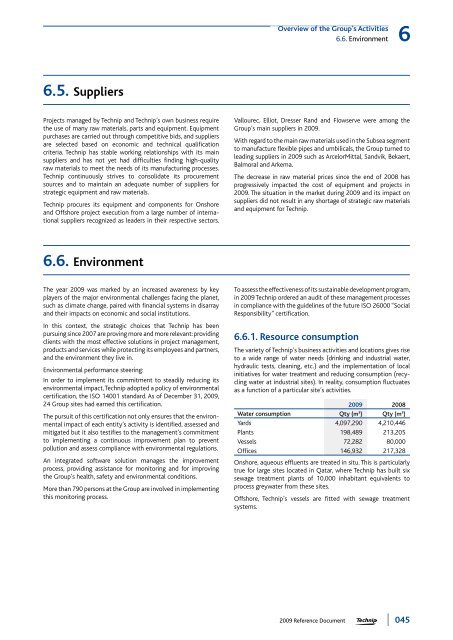Reference Document
Reference Document
Reference Document
You also want an ePaper? Increase the reach of your titles
YUMPU automatically turns print PDFs into web optimized ePapers that Google loves.
Overview of the Group’s Activities<br />
6.6. Environment 6<br />
6.5. Suppliers<br />
Projects managed by Technip and Technip’s own business require<br />
the use of many raw materials, parts and equipment. Equipment<br />
purchases are carried out through competitive bids, and suppliers<br />
are selected based on economic and technical qualification<br />
criteria. Technip has stable working relationships with its main<br />
suppliers and has not yet had difficulties finding high-quality<br />
raw materials to meet the needs of its manufacturing processes.<br />
Technip continuously strives to consolidate its procurement<br />
sources and to maintain an adequate number of suppliers for<br />
strategic equipment and raw materials.<br />
Technip procures its equipment and components for Onshore<br />
and Offshore project execution from a large number of international<br />
suppliers recognized as leaders in their respective sectors.<br />
Vallourec, Elliot, Dresser Rand and Flowserve were among the<br />
Group’s main suppliers in 2009.<br />
With regard to the main raw materials used in the Subsea segment<br />
to manufacture flexible pipes and umbilicals, the Group turned to<br />
leading suppliers in 2009 such as ArcelorMittal, Sandvik, Bekaert,<br />
Balmoral and Arkema.<br />
The decrease in raw material prices since the end of 2008 has<br />
progressively impacted the cost of equipment and projects in<br />
2009. The situation in the market during 2009 and its impact on<br />
suppliers did not result in any shortage of strategic raw materials<br />
and equipment for Technip.<br />
6.6. Environment<br />
The year 2009 was marked by an increased awareness by key<br />
players of the major environmental challenges facing the planet,<br />
such as climate change, paired with financial systems in disarray<br />
and their impacts on economic and social institutions.<br />
In this context, the strategic choices that Technip has been<br />
pursuing since 2007 are proving more and more relevant: providing<br />
clients with the most effective solutions in project management,<br />
products and services while protecting its employees and partners,<br />
and the environment they live in.<br />
Environmental performance steering:<br />
In order to implement its commitment to steadily reducing its<br />
environmental impact, Technip adopted a policy of environmental<br />
certification, the ISO 14001 standard. As of December 31, 2009,<br />
24 Group sites had earned this certification.<br />
The pursuit of this certification not only ensures that the environmental<br />
impact of each entity’s activity is identified, assessed and<br />
mitigated but it also testifies to the management’s commitment<br />
to implementing a continuous improvement plan to prevent<br />
pollution and assess compliance with environmental regulations.<br />
An integrated software solution manages the improvement<br />
process, providing assistance for monitoring and for improving<br />
the Group’s health, safety and environmental conditions.<br />
More than 790 persons at the Group are involved in implementing<br />
this monitoring process.<br />
To assess the effectiveness of its sustainable development program,<br />
in 2009 Technip ordered an audit of these management processes<br />
in compliance with the guidelines of the future ISO 26000 “Social<br />
Responsibility” certification.<br />
6.6.1. Resource consumption<br />
The variety of Technip’s business activities and locations gives rise<br />
to a wide range of water needs (drinking and industrial water,<br />
hydraulic tests, cleaning, etc.) and the implementation of local<br />
initiatives for water treatment and reducing consumption (recycling<br />
water at industrial sites). In reality, consumption fluctuates<br />
as a function of a particular site’s activities.<br />
2009 2008<br />
Water consumption Qty (m 3 ) Qty (m 3 )<br />
Yards 4,097,290 4,210,446<br />
Plants 198,489 213,205<br />
Vessels 72,282 80,000<br />
Offices 146,932 217,328<br />
Onshore, aqueous effluents are treated in situ. This is particularly<br />
true for large sites located in Qatar, where Technip has built six<br />
sewage treatment plants of 10,000 inhabitant equivalents to<br />
process greywater from these sites.<br />
Offshore, Technip’s vessels are fitted with sewage treatment<br />
systems.<br />
2009 <strong>Reference</strong> <strong>Document</strong><br />
045

















